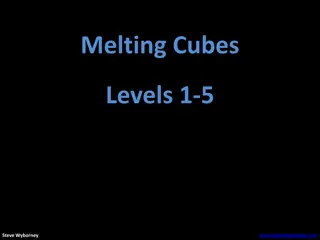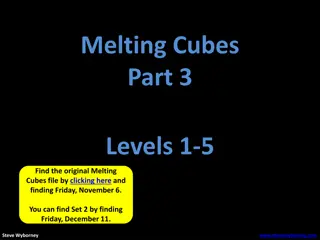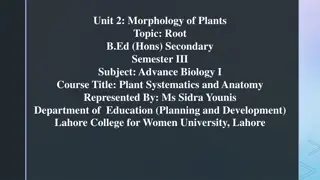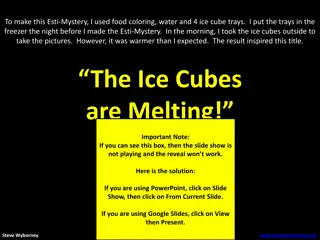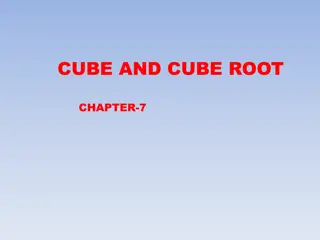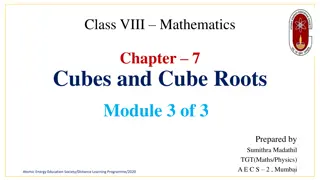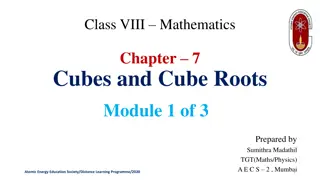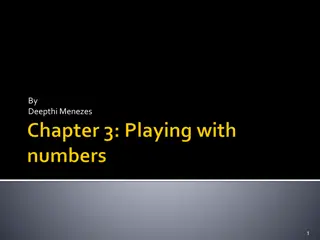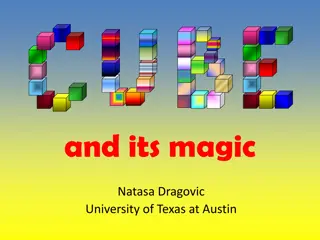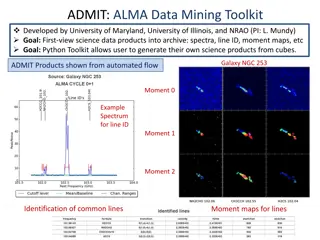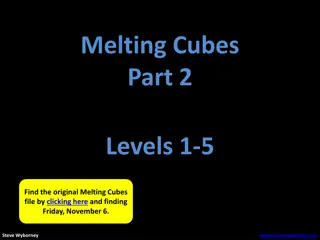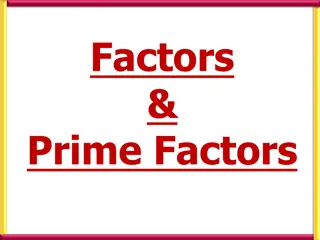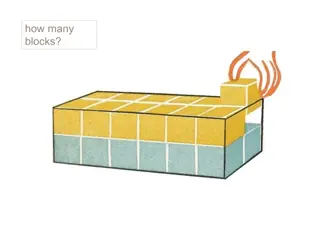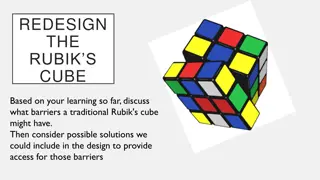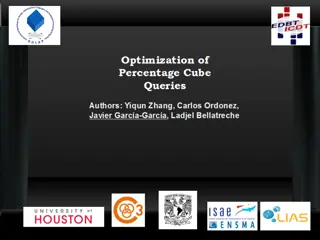Understanding Cubes and Cube Roots: Interesting Patterns and Prime Factors
Explore the fascinating world of cubes and cube roots in mathematics with insights on patterns, prime factorization, and more. Discover the relationships between consecutive odd numbers, learn how to express numbers as the sum of odd numbers, and delve into the prime factorization of cubes. Unravel the mysteries of cubes through engaging examples and interactive learning modules.
Download Presentation

Please find below an Image/Link to download the presentation.
The content on the website is provided AS IS for your information and personal use only. It may not be sold, licensed, or shared on other websites without obtaining consent from the author. Download presentation by click this link. If you encounter any issues during the download, it is possible that the publisher has removed the file from their server.
E N D
Presentation Transcript
Class VIII Mathematics Chapter 7 Cubes and Cube Roots Module 2 of 3 Prepared by Sumithra Madathil TGT(Maths/Physics) A E C S 2 , Mumbai Atomic Energy Education Society/Distance Learning Programme/2020 1
In this Module, we will learn .. 1. Some Interesting Patterns 2. The smallest multiple that is a perfect cube 2 Atomic Energy Education Society/Distance Learning Programme/2020
Some interesting patterns 1. Adding consecutive odd numbers Observe the following pattern of sums of odd numbers: 1 = 1 = 1 3 3 + 5 = 8 = 2 3 7 + 9 + 11 = 27 = 3 3 13 + 15 + 17 + 19 = 64 = 4 3 21 + 23 + 25 + 27 + 29 = 125 = 5 3 A perfect cube number is obtained when consecutive odd numbers are added. Atomic Energy Education Society/Distance Learning Programme/2020 3
. So to get 73, seven consecutive odd numbers are added- i.e., 43 + 45 + 47 + 49 + 51 + 53 + 55 = 343 = 73 Practice time: Express 63 and 83 as the sum of odd numbers using the pattern . Atomic Energy Education Society/Distance Learning Programme/2020 4
Another Pattern 2 3 13 = 1 + 2 1 3 3 3 23 = 1 + 3 2 3 4 3 33 = 1 + 4 3 3 Let us find the value of 203 193 using the above pattern. 20 3 19 3 = 1 + 20 x 19 x 3 Find the value of 513 503 using the above pattern. 513 503 = 1 + 51 x 50 x 3 Atomic Energy Education Society/Distance Learning Programme/2020 5
Yet another pattern Yet another pattern 13 = 1 13 + 23 = 9 = (1 + 2 )2 13 + 23 + 33 = 36 = ( 1 + 2 + 3 )2 13 + 23 + 33 + 43 = 100 = ( 1 + 2 + 3 + 4 )2 13 + 23 + 33 + 43 + 53 = 225 = ( 1 + 2 + 3+ 4 + 5 )2 13 + 23 + 33 + 43 + 53 + 63 = 441 = ( 1 + 2 + 3 + 4 + 5 + 6 )2 . 13 + 23 + 33+ .+ n3= ( 1 + 2 + 3 + ..+n )2 Here, the sum of the cubes of the first n natural numbers is equal to the square of the sum of the first n natural numbers. Atomic Energy Education Society/Distance Learning Programme/2020 6
2. Cubes and their prime factors Number Prime factorisation of the number Its cube Prime factorisation of its cube 4 3 = 64 4 4 = 2 x 2 64 = 2 x 2 x 2 x 2 x 2 x 2 = 2 3 x 2 3 6 3 = 216 6 6 = 2 x 3 216 = 2 2 2 3 3 3 = 23 33 153 = 3375 15 15 = 3 5 3375 = 3 3 3 5 5 5 = 33 53 Each prime factor of a number appears three times in the prime factorisation of its cube. 7 Atomic Energy Education Society/Distance Learning Programme/2020
. If in the prime factorisation of any number each factor appears three times, then the number is a perfect cube. Example : Consider the number 216. The prime factorisation of 216 is : 216 = 2 2 2 3 3 3 Each factor appears three times. i.e., 216 = 2 3 x 3 3 = ( 2 x 3 ) 3 [since a m x b m = ( a x b ) m] = 6 3 ( a perfect cube ) Atomic Energy Education Society/Distance Learning Programme/2020 8
Another example .. Is 729 a perfect cube ? The prime factorisation of 729 is : 729 = 3 3 3 3 3 3 Here factors can be grouped in triples. So 729 = 3 3 x 3 3 = ( 3 x 3 ) 3 = 9 3 So, 729 is a perfect cube . Atomic Energy Education Society/Distance Learning Programme/2020 9
. Is 500 a perfect cube ? Prime factorisation of 500 is 500 = 2 2 5 5 5. In this case, there are three 5 s but only two 2 s in the product. So, 500 is not a perfect cube. Atomic Energy Education Society/Distance Learning Programme/2020 10
Smallest multiple that is a perfect cube We can find the smallest natural number by which a number can be multiplied or divided so as to get a perfect cube. Let us see . Atomic Energy Education Society/Distance Learning Programme/2020 11
. Consider a cuboid of length 15cm, breadth 30cm and height 15cm. How many such cuboids are needed to make a perfect cube ? Let us first find the volume of the cuboid. Volume of the cuboid = l x b x h =15 x 30 x15 = 3 x 5 x 2 x 3 x 5 x 3 x 5 = 2 x 3 x 3 x 3 x 5 x 5 x 5 There is only one 2 in the prime factorisation. So we need 2 2, i.e., 4 to make it a perfect cube. Therefore, we need 4 such cuboids to make it a cube. Atomic Energy Education Society/Distance Learning Programme/2020 12
Is 392 a perfect cube ? The prime factorisation of 392 gives 392 = 2 2 2 7 7 The prime factor 7 does not appear in a group of three. Therefore, 392 is not a perfect cube. Then Atomic Energy Education Society/Distance Learning Programme/2020 13
. If 392 is not a perfect cube, find the smallest natural number by which 392 must be multiplied so that the product is a perfect cube. To make it a cube, we need one more 7. In that case 392 7 = 2 2 2 7 7 7 = 2744 which is a perfect cube[( 2 x 7) 3 = 14 3 ] Hence the smallest natural number by which 392 should be multiplied to make a perfect cube is 7. 14 Atomic Energy Education Society/Distance Learning Programme/2020
Is 704 a perfect cube? If not, by which smallest natural number should 704 be divided so that the quotient is a perfect cube? The prime factorisation of 704 is 704 = 2 x 2 x 2 x 2 x 2 x 2 x 11 The prime number 11 does not appear in a group of three. So 704 is not a perfect cube. So , if we divide 704 by 11 , then the prime factorisation of the quotient will not contain 11. i.e., 704 11 = 2 x 2 x 2 x 2 x 2 x 2 Hence the smallest number by which 704 should be divided to make it a perfect cube is 11. (704 11 = 64) The perfect cube in this case is = 64 [ 2 3 x 2 3 = 4 3 = 64] Atomic Energy Education Society/Distance Learning Programme/2020 15
Is 1188 a perfect cube? If not, by which smallest natural number should 1188 be divided so that the quotient is a perfect cube? 1188 = 2 2 3 3 3 11 The primes 2 and 11 do not appear in groups of three. So, 1188 is not a perfect cube. In the factorisation of 1188, the prime 2 appears only two times and the prime 11 appears once. So, if we divide 1188 by 2 2 11 = 44, then the prime factorisation of the quotient will not contain 2 and 11. Hence the smallest natural number by which 1188 should be divided to make it a perfect cube is 44. And the resulting perfect cube is 1188 44 = 27 (=33 ). Atomic Energy Education Society/Distance Learning Programme/2020 16
Practice Time . Practice Time . 1. Is 46656 a perfect cube? 46656 = 2 x 2 x 2 x 2 x 2 x 2 x 3 x 3 x 3 x 3 x 3 x 3 = 2 3 x 2 3 x 3 3 x 3 3 = (2 x 2 x 3 x 3) 3 = 36 3 Since all the prime factors of 46656 can be grouped into triplets, it is a perfect cube. 17 Atomic Energy Education Society/Distance Learning Programme/2020
. 2. Find the smallest number by which 675 must be multiplied to obtain a perfect cube. Prime factorization of 675 = 3 x3 x 3 x 5 x 5 Here there are three 3 s but only two 5 s. i.e., 5 does not appear as a triplet. So, if 675 is multiplied by 5, i.e., 675 x 5 = 3 x 3 x 3 x 5 x 5 x 5 = 3375 [a perfect cube, (3 x 5) 3 = 15 3] Hence, the smallest number by which 675 must be multiplied to get a perfect cube is 5. 18 Atomic Energy Education Society/Distance Learning Programme/2020
. 3. Find the smallest number by which 9720 must be divided to obtain a perfect cube. Prime factorisation of 9720 gives: 9720 = 2 x 2 x 2 x 3 x 3 x 3 x 3 x 3 x 5 Here one 3 and 5 are not in triplets. So if 9720 is divided by 3 x 3 x 5= 45 , then the prime factorisation of the quotient will not contain 3 and 5. 9720 45 = 2 x 2 x 2 x 3 x 3 x 3 = 216 (a perfect cube, 6 3 ) Thus, the smallest number by which 9720 must be divided to obtain a perfect cube is 45. Atomic Energy Education Society/Distance Learning Programme/2020 19
What have we discussed ? What have we discussed ? A perfect cube number is obtained when consecutive odd numbers are added. Some interesting patterns are shown by cubes. A perfect cube can always be expressed as the product of triplets of prime factors. We can find the smallest natural number by which a number can be multiplied or divided, so as to get a perfect cube. ^*^*^*^*^*^ Atomic Energy Education Society/Distance Learning Programme/2020 20
. End of Module 2 of 3 Atomic Energy Education Society/Distance Learning Programme/2020 21



